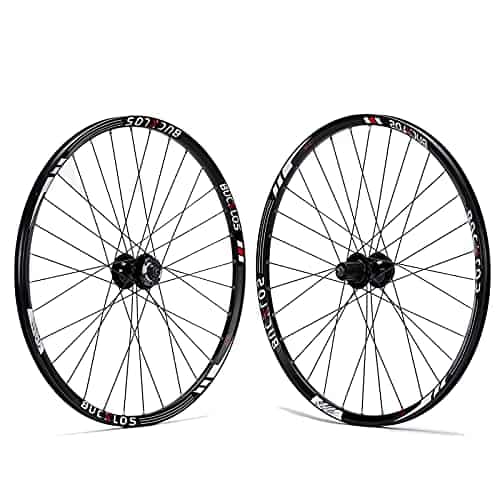The wheels on a mountain bike set it apart from any other type of bike on the market. They are knobby, thick, and can be ridden at lower air pressure. It is near impossible to ride mountain bike trails without the proper mountain bike tires.
When it comes to the size of your mountain bike tires, it’s important to make sure they aren’t too big or too small for your bike frame or body size. However, does that mean that you can change the wheel size on a pre-existing mountain bike? Or is it just easier to buy a brand new bike?
Here’s everything you need to know about mountain bike wheel size and how to go about customizing your bike to suit your needs.
Contents
Does Mountain Bike Wheel Size Really Matter?

Yes! The size of your mountain bike wheels is very important!
We never like to size-shame, but size matters when it comes to mountain bike wheels.
Having large wheels will help you ride up steep inclines when riding through mountainous trails. They also keep you stable on rocky terrains. At the same time, the suspension on larger wheels isn’t as good.
It all depends on what kind of riding experience you want to have. If you’re focused on climbing mountains and pushing through tough trails, larger wheels might be your best bet. However, smaller wheels will work better, if you want a more comfortable and controlled ride.
Size determines the level of rolling resistance you have, so rockier trails will need larger wheels.
The size of the rider will also determine what wheel size is best. A shorter rider will usually need smaller wheels.
Originally, the standard mountain bike wheel size was 26 inches. Over the years, many riders have begun using larger wheels. Nowadays, 26 inches is considered the smaller size for mountain bike wheels.
Can You Change the Wheel Size on a Mountain Bike?
Yes, you can change the wheel size on your bike.
The beauty of bikes is that most parts can be changed or customized. You can switch out the handlebars, tires, add grip tape, and swap out the seat. The wheels are no exception.
However, you have to consider if the wheel fits onto the bike. Think of it this way; you can fit a small foot into a big shoe, but you can’t squeeze a big foot into a small shoe. Therefore, it’s usually a lot easier to put smaller wheels on a mountain bike instead of sizing up.
Can I Put Smaller Wheels on My Mountain Bike?
Yes! You can put small wheels on your mountain bike!
There will be a few things to look out for when making this change that might affect your riding experience.
To start, the rim brakes may not be aligned if wheels with a different rim size are fitted onto the bike. The good news is that not all bikes have rim brakes, some have drum or disc brakes, so this may not be a problem for your mountain bike.
You are also going to decrease the overall height of the bike. This might compromise your pedaling abilities. The closer the pedals are to the ground, the more difficult it is to turn without skimming the pedals against the ground.
Finally, the steering might be altered. Smaller wheels on a larger bike will make the steering less stable. This shouldn’t seriously affect your riding, but it is something to keep in mind.
Can I Put Bigger Wheels on My Mountain Bike?

Yes! You may be able to put bigger wheels on your mountain bike.
It all depends on the bike’s clearance.
A bike’s clearance is how much space that’s been allocated for the bike wheels. A smaller bike will have a smaller clearance because the frame is narrower and not built for very large wheels.
If there is not adequate bike clearance, you cannot ride the bike with the larger rims.
You also need to ensure the mountain bike uses disc brakes. Similar to when putting small wheels on a bike, the brakes need to align with the rims. Because of the location of disc brakes, you won’t need to worry about alignment.
Larger wheels can also make the bike look and ride awkwardly. This is something to consider. If you’re attempting to fit your bike with wheels that are significantly larger than they should be, you may want to reconsider and look at other options.
Think about why you want to put larger wheels on your bike. If it’s because you’re looking for added power, you may be able to achieve some of that through thicker tires. Thick, knobby mountain bike tires can make a world of difference when riding, and they are a lot easier to install.
How to Choose a Suitable Smaller/Bigger Wheel Size for a Mountain Bike?
There are a few elements to consider when choosing a new wheel size for your mountain bike, there are a few elements to consider.
Angle of Attack
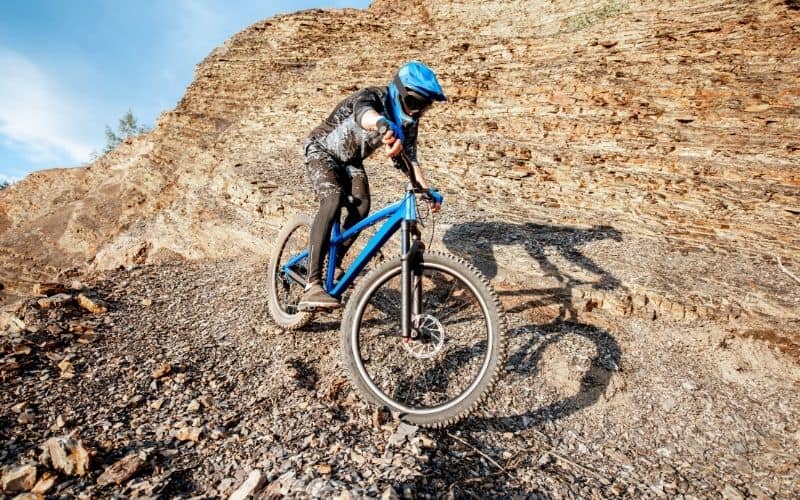
The larger the wheel is, the easier it will be to ride over large obstacles like rocks. The larger the wheel is, the smaller any bumps or inclines will appear for the rider. This is the most popular reason people go for larger wheels.
If you only plan on riding relatively flat trails, making the leap to a bigger wheel may not be necessary.
Patch Size
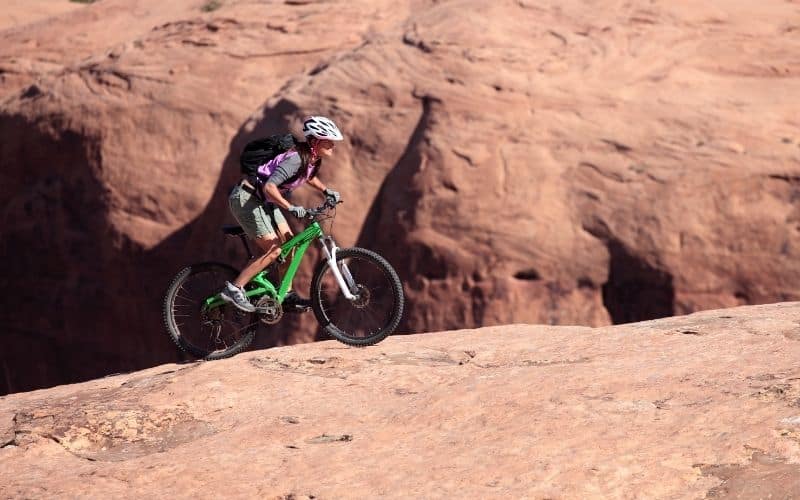
The patch size is how much wheel is touching the ground at any time. A large patch size means more traction and power when riding, especially uphill.
Thin-rimmed bike wheels like those of road bikes don’t have large patch sizes, which is one reason they would be difficult to ride on mountain bike trails.
This doesn’t necessarily mean that a larger patch size will make climbing easier, it will give you more traction which will help push the bike upwards.
Acceleration

Bigger wheels don’t mean faster wheels. If you’re looking for better acceleration, you should opt for smaller wheels. They pick up speed easier and are easy to maneuver through finicky trails.
Wheel Strength
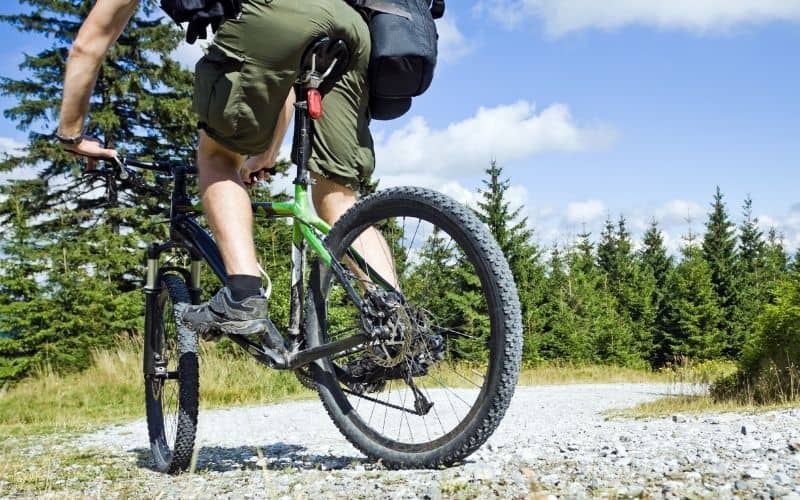
Smaller wheels have shorter spokes since there is less space in between the axel and the rim. This makes the wheel stronger since there is less space for the spokes to bend or break.
If you’re looking for more durable wheels, smaller wheels will provide that for you.
Steering
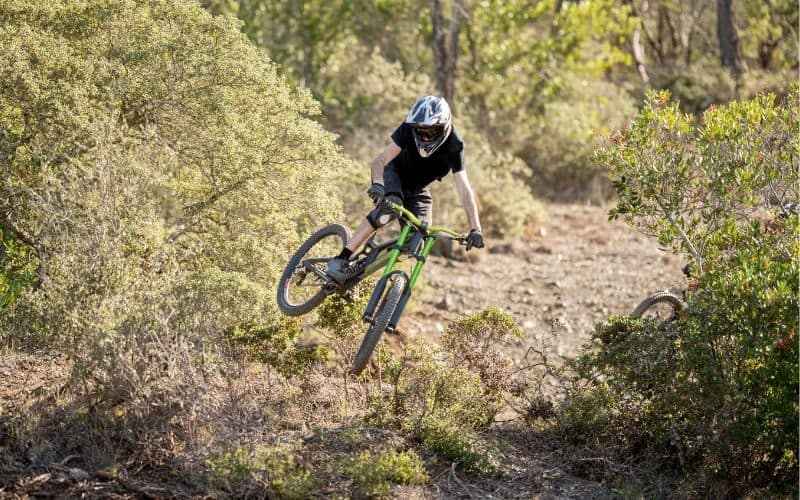
Planning on making a lot of sharp turns? Smaller wheels are your best friend.
Since there is less wheel to turn, you’ll have better cornering mechanics.
How to Put a Smaller/Bigger Wheel Size on a Mountain Bike?
Knowing how to remove and install bike wheels is a good skill for any mountain biker out there. While most cities and towns have fantastic bike mechanics, being able to change a wheel on your own may come in handy, especially if you’re out on the trails.
How to Remove Wheels
- Shift your bike into the smallest gear and chainring
- Release the brakes. You may have a brake release level built into the bike, or you might have to squeeze the brakes to release any cable tension. If you have disc brakes (which are ideal when changing wheel sizes), you won’t need to do anything
- Open the quick-release button on the wheel and loosen the bolt. The wheel should come out easily
How to Install Wheels
- If you’re putting on a larger wheel, make sure there is enough clearance. You should also check if the type of brake you have will be compatible with a wheel size change.
- Put the wheel into the dropouts, ensuring it’s fully inserted.
- Close the levers and bolts completely, making sure everything is secure. The front-wheel lever should face the rear of the fork. In the back, the rear wheel should be aligned with the chain, and the seat stays.
- Retighten the brakes. Make sure they are aligned with the wheels and can brake properly.
Can You Put 29-inch Wheels on a 26-inch Mountain Bike?

Yes! If you have a 26-inch mountain bike , you can install 29-inch wheels . However, this switch may not be appropriate for shorter riders or riders who need more stability.
Riding with larger wheels is challenging. Your steering isn’t going to be as precise, although you will be able to ride through bumpy trails with ease.
To Wrap Things Up
Changing the wheel size on a mountain bike is possible, and depending on what kind of riding you’re doing, might be a good option for you. Some bike purists will argue getting a brand new bike frame is the best option, but we don’t think you should have to spend hundreds or thousands of dollars every time you want to change up your riding experience.
Putting bigger wheels on a bike may prove to be a challenge if your bike frame doesn’t have enough clearance. Check your clearance beforehand to avoid damaging your bike or injuring yourself.
Finally, disc brakes are the best kind of brakes to have when changing wheel size. If you’re in the market for a bike, opt for one with this kind of brake system.
Have you ever changed your wheel size? How did it work out for you? We’d love to know in the comments below!
Good luck!
